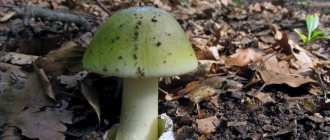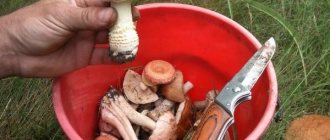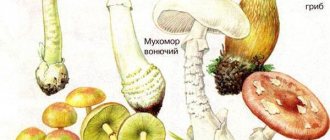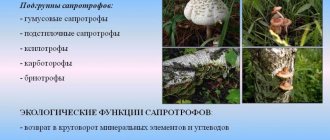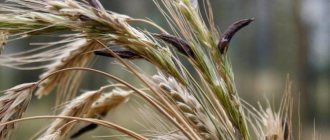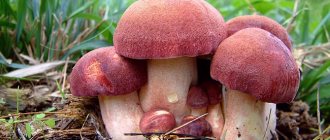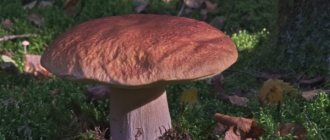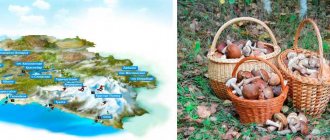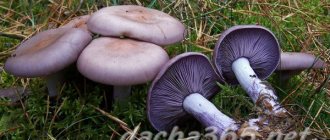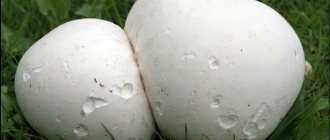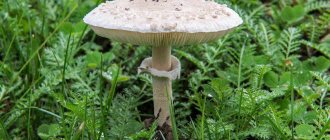At the end of summer and beginning of autumn, everyone’s favorite weather is when it is no longer so hot, especially a favorite time for mushroom pickers. After all, it is a very exciting and interesting activity to pick mushrooms in the forest, breathe fresh air, and enjoy the singing of birds. Look for edible and poisonous mushrooms, which are best avoided, of course.
However, do not forget that inedible mushrooms are also found, so we will consider most varieties of poisonous mushrooms.
Which mushrooms are poisonous? Poisonous mushrooms are those that contain certain types of toxins. Poisonous toxins lead to poisoning of the entire human body or even death. Please be very attentive and careful about the mushrooms you eat.
Below we consider the main classes and all poisonous mushrooms.
Classes of poisonous mushrooms
There are 3 main classes:
- Which cause food poisoning with poisonous mushrooms
- Which cause disturbances in the central nervous system
- Which lead to death
Of the many thousands of species of mushrooms on our planet, about 150 are truly dangerous to health and only a few species are fatal. Poisonous mushrooms in Russia number about 30 species.
Below we will consider the most common and dangerous poisonous mushrooms such as false honey fungus, toadstool, Patuillard fiber, fly agaric, pepper mushroom, satanic mushroom, wax talker, etc.
What is collected in spring, summer and autumn
The mushroom season in the Perm region traditionally begins in May and lasts until November, until the first noticeable frosts begin. There are mushrooms that delight us only for a certain time, and we need to have time to “catch” them. Some of them grow only in summer, others only in autumn. And there are those that you can collect almost the entire mushroom season. Let's take a closer look.
| Month. | Kinds. |
| May. | Morels, lines. |
| June. | Butter mushrooms, champignons, porcini mushrooms, boletus mushrooms, aspen mushrooms, champignons, russula mushrooms, chanterelle mushrooms, puffball mushrooms, tinder fungi. |
| July. | White, boletus, oak, russula, chanterelles, boletus, boletus, polypores, puffballs, champignons, umbrellas, hedgehogs, moss mushrooms, valui. |
| August. | Saffron milk mushrooms, milk mushrooms, oak mushrooms, boletus mushrooms, white mushrooms, boletus mushrooms, boletus mushrooms, aspen mushrooms, polypore mushrooms, puffball mushrooms, champignons, chanterelles, honey mushrooms, moss mushrooms. |
| September. | Russulas, garlic mushrooms, moss mushrooms, champignons, puffballs, oak mushrooms, valui, boletus, honey mushrooms, champignons. |
| October. | Russulas, garlic mushrooms, champignons, puffballs, milk mushrooms, saffron milk caps, boletus, oyster mushrooms. |
| November. | Autumn honey mushrooms, oyster mushrooms, raincoats. |
How to distinguish poisonous mushrooms from edible ones?
How to identify a poisonous mushroom? One of the signs is smell. In edible mushrooms it has a pleasant, characteristically mushroom quality. Poisonous mushrooms most often have an unpleasant, disgusting taste.
Many types of dangerous mushrooms are no different from their edible brothers and are difficult to recognize. These are called double mushrooms. But there are also those species that cannot be confused with anything else.
Different poisonous lookalike mushrooms have different characteristics and differences from edible ones; we will consider them below in each specific type of mushroom.
The first thing, of course, when going for mushrooms, you need to read the encyclopedia or our article with photos in order to visually see the types of poisonous mushrooms; after collecting the mushrooms, you need to process them within 24 hours.
If you are in doubt about the edibility of some types of mushrooms you have collected, then there are two proven ways to remove the poisonous toxins present there. These methods help in all cases except the most dangerous toadstool.
All mushrooms that even slightly resemble her are advised to be immediately avoided and not even cut off.
Important. Any mushroom, if it is overripe, has a very open cap, almost horizontally, like on a rain umbrella. Then it should not be eaten! Because poisonous spores also begin to form there.
Ways to get rid of toxins in poisonous mushrooms:
Cook mushrooms in boiling water for about 15-30 minutes. Afterwards, pour out the entire broth and rinse the mushrooms under running water. Repeat the cooking procedure in boiling water again. And after that you can definitely eat your favorite mushrooms. Make soups, twists, pickle. Poisonous mushrooms lose most of their toxins when cooked.
The second method is drying mushrooms. It is necessary to dry by hanging the mushrooms on a thread in a well-ventilated area. In this case, when drying, all toxins will evaporate. If you just put mushrooms, for example, on a newspaper and on a pipe, then the toxins are released and can be partially absorbed back. This option is not reliable.
Below are photos and descriptions of poisonous mushrooms for you, a table with examples of the external differences between poisonous and edible mushrooms.
Omphalote olive
Omphalote olive or Omphalotus oleaginous is often called false chanterelles. The poisonous mushroom grows in families on the rotten remains of deciduous trees in central Russia, Crimea, European countries, and on the Black Sea coast. These mushrooms are distinguished by their ability to glow in the dark. False chanterelles are smoother and fleshier than their edible twins; they do not have an orange tint; they are recognized by their unpleasant smell and yellowish flesh. Illudin S toxin is not lethal, but food poisoning is guaranteed. Dehydration occurs due to diarrhea and vomiting.
Toadstool pale
The most poisonous mushroom! The caps are about 5-14 cm, the legs are 8-16 cm. The cap is often white, light gray or light green. Even ordinary berries and mushrooms growing nearby are best avoided because... The spores of the toadstool are very poisonous and are easily carried by the wind.
It is often confused by mushroom pickers with champignon. The main differences between these mushrooms:
- The plates that are located under the cap of the toadstool are white. The champignon has a pinkish tint.
- When the legs of a toadstool are broken, it will remain white. The champignon will change color.
- The toadstool has no smell. The champignon has a light pleasant aroma of almonds and anise.
Patouillard fiberglass
It grows in entire families and is a representative of agaric fungi. It appears in coniferous and deciduous forests, as well as in parks and artificial forest belts already in early May and maintains its populations until August. It is found in both Asia and Europe.
When young, it has a white cone-shaped cap and can easily be confused with a champignon. With age it turns yellow and then turns red. The edge of the cap, whose diameter ranges from 3 to 9 cm, is wavy and cracks over time. The under-hat plates are thin, at first they are white, then darken and acquire a brown tint. The cylindrical stem of the mushroom is small in height - only 1.5 cm. It has a smooth surface and matches the color of the cap.
When cut, the white flesh turns slightly pink and attracts with a soft fruity aroma. An important feature: the entire mushroom is the same color, the stem at the bottom has a noticeable thickening.
Satanic mushroom
The caps are about 8-30 cm, the legs are practically square in proportion, the height is about 5-14 cm, the thickness is 3-9 cm. The caps are often dirty gray or white-greenish in color.
When broken, it changes its color to bluish or reddish. Old mushrooms smell unpleasant, the smell is reminiscent of rotten onions. In its raw form, the mushroom is definitely incredibly dangerous, but in some countries it is considered conditionally edible and can be eaten after heat treatment.
fly agaric
The most recognizable and beautiful poisonous mushroom.
It is difficult to confuse it with any other. The cap size is about 8-20 cm, the thin stem is about 8-20 cm high. The cap is red or orange with white round spots. There are many varieties of this mushroom. It is especially known for its use in folk medicinal purposes. For certain recipes, decoctions, ointments, and tinctures are made. Which help with pain, including in joints, tumors, heal wounds faster and have various other properties that are constantly being researched and used even in modern drugs. In past centuries it was especially popular in medicine. And also in everyday life. People noticed that insects that land on the cap of the mushroom die - this is how its name “fly agaric” appeared.
3. Lepiota brown-red
The unsightly appearance of this mushroom most often forces mushroom pickers to simply pass by it. But still, cases of poisoning are recorded, and half of them end in human death. Lepiota brown-red is extremely poisonous; one cap is enough to produce a lethal dose of toxins. It contains cyanides and nitriles, for which there are no specific antidotes. The first signs of poisoning appear within 10 minutes, and within half an hour a person can die from cardiac arrest. Most often, the ambulance simply does not have time to get there during this period. Some sources claim that the main distinguishing feature of this mushroom is its smell, similar to the aroma of orange syrup.
Peppery
The caps are about 2-7 cm, the stem is thin, about 3-8 cm high. Among mushroom pickers there is often a debate about its toxicity, but scientists have proven that the mushroom is poisonous; it just has a very long-lasting poison effect.
It does not begin to act immediately, but is capable of accumulating in the human body and gradually destroying the liver. Most often it grows in various coniferous forests.
Greenfinch
Greenfinch grows in small groups in dry coniferous forests on sandy soils in North America and Europe. Until recently, it was considered a good edible mushroom, but after the publication in 2001 of a report of poisoning due to the consumption of large numbers of greenfinches (12 cases, 3 of them fatal), it is suspected of being poisonous. Symptoms of poisoning include muscle weakness, pain, cramps, nausea and sweating.
5
Waxy talker
The size of the cap is about 5-11 cm, the thin stem is up to 5-8 cm high. The cap is white, smooth, slightly shiny, hence the name “waxy”.
It is especially dangerous for sick people, the elderly or young children. It is easier for a healthy person to tolerate its poisoning. Symptoms of poisoning with poisonous mushrooms appear quite quickly from 30 minutes to 6 hours. Nausea, vomiting, fever. You should immediately consult a doctor if you have suddenly eaten any mushrooms you have cut yourself.
Yellow-skinned champignon
The cap size is about 5-14 cm, the stem is thin, the height is about 6-11 cm. The cap is white.
The difference from regular champignon is that the flesh turns yellow when pressed with a finger or broken. Hence the name “yellow-skinned”. Causes mild poisoning, but of course everything depends on the dose. Wide range of growing habitats available to people. These are not only deciduous forests, but also all kinds of parks and alleys where there are trees and tall grass. Therefore, you need to be especially careful with this species. Even children walking in the park can find and pick them.
About the artist
“One day, returning from the forest, I admired the porcini mushrooms I had just found. It was very sad to realize that now this beauty would disappear, becoming just food. I decided to draw them so that they would remain in memory. This is how I got my first mushroom portraits. This was almost forty years ago, and I still continue to draw them. The world of forest joys has expanded incredibly for me. Now a beautiful russula can give me no less pleasure than a porcini mushroom. Mushrooms are wonderful subjects for painting. They contain all the richness of colors, shapes, textures. They are great for learning a variety of artistic techniques. Drawing them is great fun. I really want to share this pleasure with all those who are in love with mushrooms and infect some of my readers with this fascinating activity. When there are mushrooms, I draw them only from life” ( Alexander Vyazmensky - artist, naturalist, teacher. Recognized master and popularizer of an amazing direction - botanical painting). Alexander regularly conducts master classes in botanical painting in St. Petersburg and Moscow. You can find out how to get there in his VKontakte group.
“Alexander Vyazmensky (b. 1946 in Leningrad) is a master and popularizer of an amazing trend - botanical painting. His works are in many Russian and foreign collections, including the Minneapolis Institute of Arts, Farlow Library, Hunt Institute of Botanical Documentation (USA), London Botanical Garden, Lindley Library, Shirley Sherwood Collection (England), Grand Hotel Europe (St. Petersburg), private collections of America, England, Australia, Germany, the Netherlands. He illustrated the Red Book of Russia, the Red Book of St. Petersburg, the Red Book of the Novgorod Region and the Kola Encyclopedia. Airy and unusually realistic watercolors by Alexander Vyazmensky amaze with their scrupulous accuracy in conveying shapes and colors. His mushroom portraits are in perfect harmony with the white surface of the paper, giving the viewer’s imagination the opportunity to complete all the missing details of the forest where the depicted mushroom was found. And Alexander’s landscape sketches are not only mesmerizing, they beckon, calling you to kneel down and crawl to that tree, under which a porcini mushroom is hidden, covered with forest grass” (planet-gribov.rf - website of the St. Petersburg Mycological Society).
Rooting boletus (Boletus radicans)
This mushroom is one of the few inedible bolethaceae found in the Leningrad region. But, since it is typical of much more southern regions, it can be found extremely rarely, in areas with a warm and mild microclimate. Forms mycorrhiza (symbiosis) with oaks and birches. Inedible due to bitter pulp. And the bitterness does not disappear during heat treatment. The cap is 6–20 cm in diameter, at first hemispherical, then convex in shape with protruding edges. The skin is usually dirty gray or brown-gray. It differs from edible boletaceae by a characteristic feature: the color of the upper part of the leg is lemon-yellow and close to the color of the tubular layer. The pulp turns blue when pressed and broken.
Gall mushroom (Tylopilus felleus), bitterling, false white
Another representative of the inedible boletaceae, this time very characteristic of our forests. It is not poisonous, but the reason for its inedibility is the same - a very bitter taste, which is enhanced by heat treatment. Most often it is confused with the boletus, but it can be distinguished by the yellowish mesh pattern on the leg (in the boletus it is covered with black flake-like scales) and the pinkish color of the tubular layer, which becomes more pronounced when broken and pressed. And it differs from white ones, with which it is also confused, by a darker mesh (in boletus, the mesh is lighter than the main color of the leg). Grows from June to September in all types of forests. Prefers mixed with spruce. Can climb onto stumps and trunks of fallen and living trees.
Fat pig (Tapinella atrotomentosa)
A very beautiful mushroom, but mycologists still have disagreements about its edibility. So you shouldn't eat it. Slender mushroom (Paxillus involutus), a related species, is now classified as a poisonous mushroom. It is, however, almost impossible to confuse these two types. The thick one differs from its insidious sister, first of all, in that it has an almost black velvety short leg and a sharp light transition to the plates. And a much meatier cap. The thin stem darkens only in very unfavorable weather conditions. In normal weather it is lighter than the color of the cap. An interesting fact is that pig mushrooms, despite the fact that they are agaric mushrooms, are classified by scientists as boletaceae. It grows in both coniferous and mixed forests, often found on stumps. Common from July to September.
Red fly agaric (Amanita muscaria)
This elegant mushroom has been known to everyone since early childhood: from fairy tales, pictures in books, cartoons. Fly agaric is widespread in temperate climates. Birch and spruce are the favorite trees of the red fly agaric, but it also grows with many other species, coniferous and deciduous. Found from July to early November, alone and in groups. The mushroom is poisonous and contains several groups of toxins with different effects. According to legend, in ancient times it was used by berserker warriors for courage and by shamans to enter a trance. Flies were lured and poisoned using milk with pieces of fly agaric. Hence the Russian name. But some forest animals (elk, deer, squirrels, bears) eat fly agaric for medicinal purposes. Slugs also do not disdain fly agaric.
Amanita citrina, lemon
Grows in any type of forest (coniferous, deciduous, mixed). In the Leningrad region this is a common species. Found from August to late October, singly and in groups. Prefers sandy soils. “Friends” in coniferous trees with pine and spruce, and in deciduous trees with birch and oak. The hat is at first semicircular, then opens up. The color of the cap ranges from almost white to characteristic lemon-yellow and light greenish shades. The surface of the cap is covered with large thick scales of light gray or brownish color. The leg has a club-shaped thickening (volva) and a pale lemon-colored wide ring characteristic of Amish. This fly agaric is an inedible, and, according to other sources, a mildly poisonous mushroom. The greenish-yellow tint and typical “fly agaric warts” on the cap arouse reasonable suspicion among mushroom pickers.
Panther fly agaric (Amanita pantherina)
Grows in coniferous and mixed forests. Prefers light soils and loves fire ditches. Found mostly singly. Not uncommon in the Leningrad region. The color of the cap is chocolate brown, at a young age the cap is densely covered with small white flakes, it becomes lighter with age; in dry forests there are mushrooms with yellow-grayish and almost white caps. One of the distinguishing features is the low ring on the stem. Volva is attached, white in the form of a rim of 1–2 rings. The mushroom is highly poisonous, much more dangerous than the red fly agaric. But its greatest danger is its resemblance to the edible gray-pink fly agaric. Now it has become fashionable to try all kinds of mushrooms. The main distinguishing feature of the gray-pink fly agaric is the change in color of the flesh to pinkish or reddening at the break. Panther color does not change.
Porphyry fly agaric (Amanita porphyria)
This species is a fairly common member of the fly agaric family, but is also little known. This is apparently due to the fact that the mushroom is relatively small and does not catch the eye. It is found everywhere in coniferous and mixed forests of temperate and northern regions of Russia. Not uncommon in the Leningrad region. Growth is observed from mid-July to the end of October. The cap of young mushrooms is rounded-conical, while that of adults is spread out. This fly agaric is distinguished by the fact that it quickly loses the characteristic scales on its cap, which is why it is easily confused with floats, especially since its ring also quickly disappears. It is considered a mildly poisonous or inedible mushroom. The pulp has a faint odor of raw potatoes.
Royal fly agaric (Amanita regalis)
Quite a rare species for the Leningrad region. The diameter of the cap varies widely - from 5 to 25 centimeters. The shape of the cap is initially spherical, and its surface is densely covered with yellowish or white flakes. Over time, the cap becomes convexly spread out, often with a raised ribbed edge, while its surface remains strewn with numerous yellowish or whitish warty flakes on a yellow-brown or ocher-brown background. The color in the center of the cap is darker. Often located wide plates of white color become yellow-cream with age. The flesh of this fly agaric is brittle, rather thick, white, without a special odor, and directly under the skin the color of the flesh is golden yellow. This mushroom is not edible.
Amanita virosa, white toadstool
This species, unlike the pale grebe (Amanita phalloides), which is rare in our country, is widespread in the north of Russia. In the Leningrad region it is found from July to September, often growing in groups in coniferous and mixed forests, along the outskirts of swamps. It differs from other “toadstools” in the very light, almost white color of the fruiting body. It has well-defined flocculent scales on the stalk. The toxins of this species are very similar to those of the toadstool. The mushroom is deadly poisonous! To the point where you can accidentally tear it off and then rub your eyes and get temporary blindness. But its strong toxicity does not prevent insects and slugs from consuming it. An interesting distinctive feature is that the edges of the cap are often asymmetrical, which is why the mushroom looks somewhat “lopsided”. There is a ring on the leg, thin and uneven, from which in adult specimens often only an inconspicuous belt remains. It is very undesirable to pick it up - especially for children.
True tinder fungus (Fomes fomentarius), common
Prefers deciduous trees: birch, alder, oak. Widely distributed in the Leningrad region. The mycelium is completely hidden in tree trunks, the fruiting bodies are perennial, and by the folds you can even determine the approximate age of the mushroom. Most often it lives on dead trees, but can also attack weakened trees. Causes white rot of trees, but also promotes the decomposition of dead wood. The fruiting bodies are often massive, hoof-shaped, of various gray shades, the lower part is flat, light, and darkens when pressed. There are no poisonous species among our tinder fungi. But the species presented in the newspaper are inedible due to their hard, tasteless pulp. Real tinder, cut into thin strips and dried, was used as tinder to start a fire. There is also information that its pulp has a hemostatic effect.
False polypore (Phellinus igniarius), burnt
It can also grow on birch and willow trees. The main difference is the color of the tubular spore-bearing layer. The false polypore has a tubular layer that is reddish or even brown in color, and the fruiting body is more prostrate, often with deep cracks. Strictly speaking, Phellinus igniarius is a species complex, the boundaries and scope of which species are defined differently by modern scientists. All representatives of the complex are characterized by seasonal variability in the color of the hymenophore. In the spring, in most cases we will see a gray tubular layer that has faded over the winter. Sometimes nascent brown tubes are visible in the center. By May, the hymenophore almost completely turns brown, leaving only a gray border around the edge. In June the region also turns brown.
Edged polypore (Fomitopsis pinicola), pine
The fruiting bodies are perennial, with a pungent, peculiar odor, often sessile (no stalk as such), woody, flattened. The edge is usually much brighter than the main body of the tinder fungus, ocher-orange in color, and slightly shiny. An interesting phenomenon can be observed on the young fruiting bodies of this tinder fungus - guttation (secretion of transparent droplets, as if the mushroom is “crying”). The pulp is yellowish, dense. The underside of the cap is creamy. Despite the name, it is also found on deciduous trees. One of the most common and fairly large tinder fungi in our forests. Causes brown rot of the host tree. It can settle on buildings and lumber, destroying them. Inedible, but used in folk medicine, although in case of overdose there is a danger of poisoning.
Trametes ochracea
The fruiting bodies are annual or overwintering, usually imbricate, sessile. The surface of the cap is slightly felted or suede, almost smooth, with multi-colored concentric zones. The color is dominated by yellow and brown tones. The color of the lower surface of young fruiting bodies ranges from milky white to cream; when dry, it darkens slightly. It is found on dead and dead trunks, stumps, branches of birch, oak, alder, aspen and other deciduous trees. Rarely lives on conifers. Sometimes it forms large accumulations. Inedible due to dry, thin, but rather tough pulp. There is a similar twin - Trametes versicolor, which is much more varied in color.
Purple web spider (Cortinarius purpurascens)
Grows in coniferous and mixed forests in August–September. Occurs more often in small groups. At a young age, the cap is hemispherical, with edges curved inwards, mucous to the touch, later it becomes convex, and in mature ones it is spread out and sticky-fibrous to the touch, reddish-brown or olive-brown in color. Cortina (webbed) is weak, slimy, whitish in color. The leg is thickened below, dense. It is named cobweb for the characteristic “cobwebby” blanket that connects the edges of the cap with the stem, and the name “crimson” is for an interesting feature of the pulp: when intact it is blue-violet, but when cut it becomes purple. The mushroom is little known and is considered inedible, but it is not poisonous.
Goat's web spider (Cortinarius traganus), stinking
Prefers damp, mossy places in coniferous and mixed forests. Growth time: June–October. It is common in the Leningrad region. It differs from other purple web spiders in its unpleasant odor, for which it was so named. Another characteristic feature is that the pulp, when damaged or broken, quickly acquires a rusty-brown color. And the cobwebs and plates of adult mushrooms are of the same color. There is a very similar twin - camphor spiderwort (Cortinarius camphoratus) with purple plates, which also has a pronounced odor. Here we can say that often the smell of the mushroom is very important in its definition. Both cobwebs are considered inedible precisely because of their unpleasant odor.
Azure web spider (Сortinarius azureus)
Grows in deciduous and mixed forests, singly or in small groups. The cap is initially convex, then spread, with a blunt tubercle, bluish-violet, then yellowish-grayish-violet or yellowish-brown, 3–7 cm in diameter. The plates are adherent with a tooth, at first bright bluish-violet, then brownish, with a violet tint and rusty-brown, wide, thin. The leg is thickened towards the base, initially bluish-violet, then brownish, under the cap remains bluish, without girdles, 6–12 cm high and 0.7–1.5 cm thick. The pulp is initially bluish-violet, then whitish, tasteless and odorless . It is rare in the Leningrad region. More southern view. Even an experienced mushroom picker can easily confuse it with other purple spider webs. Therefore, it is not recommended for food, although it is not poisonous.
Brilliant web spider (Сortinarius evernius)
It grows from mid-August to the end of September in coniferous and mixed forests (with spruce, birch), in damp places, near swamps, in moss, on litter, found in small groups, not often. Cap: up to 8 cm in diameter, at first bell-shaped or hemispherical, dark brown with a lilac tint, with whitish silky remains of the cover along the edge, hygrophanic (this means a rather strong change in the color of the mushroom cap in rainy weather; many types of honey mushrooms have the same feature). The stem of this mushroom is often narrowed to a purple-tinged base, hollow, with white concentric bands. The plates are mid-frequency, gray-brown, later dark, also with a purple tint. Inedible.
Half-haired web spider (Cortinarius hemitrichus)
Another type of cobweb found in marshy areas, most often in deep moss or at the base of mossy stumps. Prefers mixed forests (birch-spruce), forms mycorrhiza (symbiosis) with birch. The mushroom is small (the cap rarely reaches 4 cm in diameter) and almost always grows in small groups. The cap is slightly velvety, gray-brown, often with a pronounced tubercle and a light border, hygrophanous. The cobwebby blanket is white. A whitish ring is clearly visible on a thin long leg. The leg is hollow inside. The plates are fused with a tooth, rather sparse, wide, at first light brown, then darken. The flesh of the mushroom is also brown. Grows in August–September. Due to its small size and the presence of several similar species, with which even scientists sometimes get confused, it is considered inedible.
Light buffy web spider (Cortinarius claricolor)
This spider web is found in pine forests with an admixture of birch, which is quite typical for the Leningrad region, among green and white moss. Usually only the cap is visible in the moss. From a distance, a young light ocher cobweb can be confused with a porcini mushroom, but when you come closer and unscrew the thick stalk from the moss, instead of tubes you see a white cobwebby blanket and plates. The cap is light brown, almost spherical in young ones, then opens. The leg is smooth, dense, light gray. The mushroom grows quite large, and in its adult state it is difficult to confuse it with something else. In our forests it is widespread and common, but at the same time little studied. Information about edibility is very contradictory: from edible to slightly poisonous. Therefore, we cannot recommend it for use.
Gymnopilus junonius
One of the most beautiful and largest gymnopiles, it grows in mixed and deciduous forests, often next to oak on stumps and buried wood, usually in groups or bunches. The mushroom is dense, the cap is hemispherical, later convexly spread, covered with small scales. The color is bright, yellow-orange. The leg is slightly darker than the cap, in the upper third there is a ring or a trace of it. The plates are frequent, wide, bright, yellow or yellow-ocher in young mushrooms, darkening in adult specimens. The pulp is yellow, often with an almond odor. In the Leningrad region it is quite rare, from July to the end of September. The mushroom is categorically inedible due to its highly bitter pulp. At a very young age, it can be confused with the summer honey fungus, but it does not have yellow plates or the smell of almonds.
Golden phaeolepiot (Phaeolepiota aurea), grass scale
It is found in our region in parks, in nettle thickets, in thick grass and bushes. That is why it is little known to most mushroom pickers. Although the mushroom in adulthood is very large and noticeable. The cap is massive, orange-ocher, covered with scales of the same color, which is why it appears velvety. The leg is also powerful, up to 20 cm in height, often widening towards the base. In young mushrooms, both the stem and the cap are wrapped in a velvety dense blanket, which subsequently breaks and leaves a rather wide shaggy ring on the stem. Data regarding the gastronomic qualities of herbal flakes vary. According to some data, the mushroom is classified as edible. According to others, more recent, the mushroom contains hydrocyanic acid and is therefore not recommended for consumption.
Hornemann's stropharia (Stropharia hornemannii)
Named after the famous Danish botanist Jens Hornemann. It grows in coniferous and mixed forests, often on stumps and buried wood of pine and spruce, and in moss. Often forms groups, but can also be found alone. The mushroom can reach quite large sizes. The cap is up to 12 cm, smooth, brown-brown, slightly sticky. Its edge is usually with hanging remnants of a private blanket of white color. The leg is high, up to 15 cm, cylindrical, often curved, with abundant light scales. It has a ring in the upper third. The plates of young mushrooms are almost white, later gray with a lilac tint. Sometimes it has an unpleasant odor, and the pulp of adult mushrooms is bitter. For these reasons, it is considered inedible by most sources. Occurs frequently from July to October.
Soap row (Tricholoma saponaceum)
The cap is medium-sized, fleshy, from convex to semi-prostrate, very variable in color: often greenish-gray, with matte white edges, unevenly colored. The leg is smooth, often lighter than the cap, and sometimes covered with small scales. The flesh may turn pink. The plates are rare, fragile, light yellow or with shades of gray. It grows in mixed and coniferous forests, on the soil, usually in small groups, from mid-summer to late autumn, and can tolerate short-term frosts. It is considered inedible due to its unpleasant soapy smell, which, however, is not always pronounced. It has a similar poisonous twin - the pointed row (Tricholoma virgatum) with a lead-colored cap and a much more pronounced sharp tubercle.
Hypholoma capnoides, Hypholoma poppy
Frequent inhabitant of coniferous and mixed forests. It grows in groups on stumps and buried wood, has no ring on the stem, and is nicknamed poppy for the very characteristic bluish-gray color of its blades. The cap is light yellow, and in damp weather it takes on a much richer color. In fact, the mushroom is edible, but we considered it possible to show it in this newspaper due to the presence of very dangerous poisonous counterparts. These are the sulfur-yellow honey fungus (Hypholoma fasciculare), distinguished by rather bright yellow-green plates, and the bordered galerina (Galerina marginata), with which young honey mushrooms can be confused. Galerina has a noticeable ring on a velvety stem with a white coating, brown plates and a noticeable light border along the edge of the cap. All these species can be found in mixed forests.
Fly agaric "bouquet"
“Mushroom portraits” performed by the master are in perfect harmony with the white surface of the paper, giving the viewer’s imagination the opportunity to complete all the missing details of the forest where the depicted mushroom was found. Like the people in the portraits, Alexander Vyazmensky’s characters are surrounded by objects from their native world: mosses, leaves, twigs. This watercolor shows: red fly agaric, panther fly agaric, lemon fly agaric and in the lower left corner - the same gray-pink fly agaric (Amanita rubescens), edible and distinguished from all others by the redness of the flesh when damaged and when cut. But without precise knowledge of its distinctive features, it is better not to collect it. Young specimens change color very little, and it grows in the same biotope as the poisonous panther fly agaric.
Entoloma poisonous
The size of the cap is about 5-17 cm, the height is about 4-15 cm. The hat is flat, wide, light with different shades.
It loves warmth and light, so it most often grows actively in bright mixed places from late May to early October. They grow both singly and in groups. Symptoms of poisoning with poisonous mushrooms appear very quickly from 30 minutes to 2 hours. Headache, intestinal upset. In common parlance it is often referred to as the giant rose-plate plant. Because it has pinkish plates under its cap.
Russula is hotly caustic (emetic)
The legs are white up to 8 cm, the cap is red with a diameter of 7-11 cm. The name already makes a lot clear about this species. The mushroom tastes very bitter. True, with the necessary heat treatment, the bitterness goes away, but still the mushroom is poisonous and, as is also clear from the name, the first sign is vomiting.
- Talker - description of the species, distribution of the species, benefits and harm + 79 photos
- Gall mushroom - description of appearance, seasonality, taste + 69 photos
- Rizhik - where and at what time it grows, benefits, recipes + 90 photos
It prefers shade and grows near peat soil, near swamps.
Galerina bordered
The size of the cap is about 1-3 cm, about 2-8 cm high. These small mushrooms are very toxic, containing poison similar to the most dangerous mushroom - the poisonous toadstool. It grows actively from June to October. Prefers to live on rotten wood. Therefore, you can find it in any forest.
Other poisonous mushrooms
In addition to the mushrooms we discussed above, there are many more species.
Such as, thin pigwort, panther fly agaric, stinking fly agaric, common morel, mountain cobweb, reddish talker, poisonous lepiota, brilliant cobweb and dozens of other species. All of them are very dangerous for your health and the health of your loved ones and most of them are very easy to confuse with edible mushrooms. Therefore, we remind you to please be very careful if you collect mushrooms yourself in the forest. They must smell pleasant and not be overripe. When processing at home, be sure to boil for at least half an hour and then rinse under running water. It is necessary to process cut mushrooms within one day. Afterwards you can cook as you like. This is done so that if you come across an inedible mushroom, it will cause the least possible harm.
Any signs of poisoning with poisonous mushrooms after eating (even if only 30 minutes or even 6 hours have passed), be it fever, nausea, vomiting, diarrhea, dizziness - be sure to consult a doctor to be on the safe side! So that a wonderful and joyful family mushroom trip does not turn into horror. We wish you good health.
A few final words
To conclude the article, I would like to say that in nature, in addition to deadly poisonous mushrooms, there are also simply highly poisonous ones. First of all, this is the panther fly agaric
(amanita pantherina) containing muscarine, hallucinogens (muscimol, ibotenic acid), as well as the toxins scopolamine and hyoscyamine, which are part of such poisonous plants as henbane and datura. This mushroom also has a significant resemblance to the edible gray-pink fly agaric.
Among other highly poisonous mushrooms, it is worth highlighting tiger row
(tricholoma pardinum) and
poisonous entoloma
(entoloma sinuatum), which are quite rare and contain unknown toxins. Mushrooms of the genus “fiberwort”, which are unremarkable in appearance, can also turn out to be very dangerous (almost all of them are poisonous or inedible). You need to be careful with some mushrooms from the genus “spider web”, due to their insufficient knowledge.
My story about the most poisonous mushrooms has come to an end. I hope the information presented in the article will help you avoid life-threatening mushrooms from getting into your baskets. Happy hiking in the forest, friends!
Features of poisoning
The most common signs of poisoning by poisonous mushrooms are stomach upset, nausea, vomiting, diarrhea, fever, and less often dizziness. There is also a weak pulse and cold extremities.
If there are any signs, the most important thing is to go to the hospital and see a doctor as quickly as possible. Because it is very difficult to deal with poisons on your own and you cannot waste time, so as not to lead to complications.
Foliotina wrinkled
On the seventh line in the list of the most dangerous and poisonous mushrooms in the world is Foliotina rugosa, a poisonous mushroom that grows in Europe, Asia and North America. Contains a powerful poison called amatoxins, which is very toxic to the liver and is responsible for many deaths. Sometimes these mushrooms are confused with Psilocybe blue.
6
Advice from mycologist M. Vishnevsky
Russia is very rich and prolific in various delicious mushrooms. And has one of the largest consumption in the country. In some countries, mushrooms are not eaten at all. In Russia, approximately one person per year consumes about 10 kg of various mushrooms.
To ensure that this tasty and healthy protein-rich product brings only benefits, Mikhail Vishnevsky, the chief mycologist of Russia, advises adhering to the following principles:
- Show mushrooms that are new to you to an experienced mushroom picker, or it’s better not to pick them at all
- collect already known and proven species
- collect in cleaner ecological places, no need to cut near the roadway, near factories or chemical zones and fields. They use chemicals to poison insects.
- do not forget to look at the color, appearance, shape and smell of the whole mushroom, as well as when broken
- Do not handle obviously poisonous ones, such as toadstools, with your bare hands. This is especially true for children because... for example, the fly agaric is very beautiful and attractive
- do not take shortcuts in an unknown new area, for example when traveling to a new place on vacation
- Before starting cooking, carefully sort through and discard any suspicious-looking old or rotten
- follow the cooking process fully
- Do not give dishes with mushrooms to children under 6-7 years old and the elderly
- Any suspicion of poisoning - call the hospital immediately
That's all the basic rules. We wish you clear weather.
Ergot purpurea
Ergot purpurea is a special type of macromycete that parasitizes cereals. The purple growths resemble fangs. In Russia, growths on rye were called “uterine horns.” When harvesting grains, they got into the bread and caused poisoning. Currently, damage caused by purpurea ergot poisons is rare. They end up in flour when organoleptic control is not carried out.
In the Middle Ages, damage to purple ergot alkaloids was widespread. They went down in history as epidemics caused by the “fire of St. Anthony.”
Currently, mushrooms are found only on wild cereals. After treating fields with herbicides, fungal spores die. Ergot purpurea is extremely rare in developed countries. Modern methods have made it possible to almost completely get rid of ergot.
